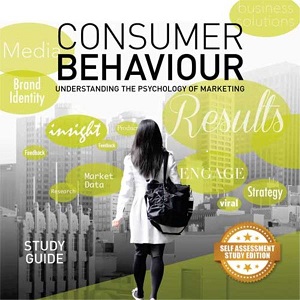
Sneak Peek
Improve your sales by applying human psychology skills
We are all consumers but there are many reasons why we choose certain products or services over others. Advertising plays a role but so too do other factors like brand personality, brand loyalty, and ethics. Smart sellers work out who their target market are and learn more about their needs and desires. This course equips the learner with a wide range of information to better understand consumer decision making processes and to successfully market products.
Course contents
The course is delivered in 6 lessons.
LESSON 1: WHAT IS MARKETING PSYCHOLOGY?
- An Overview
- Roles in Marketing Psychology
- Qualifications and Jobs
- Applications of Marketing Psychology
- Myths About Marketing Psychology
- Future Directions
LESSON 2: WHO WE SELL TO - UNDERSTANDING THE CONSUMER
- Principles of Marketing Psychology
- The Buying Process
- Target Market
- Geographic
- Demographics
- Psychographics
- Other Influences on Consumers
- What We Sell
LESSON 3: PSYCHOLOGY OF CONSUMER BEHAVIOUR
- Introduction
- Gestalt Principles of Perception
- The Iceberg Principle
- The Dynamic Principle
- Emotions and Buying Behaviour Response
- The Meaning of Colours
LESSON 4: MARKET RESEARCH TECHNIQUES
- Introduction
- Gathering Data
- Testing Products
- Testing Advertisements
- Market Segmentation
LESSON 5: WHERE WE SELL
- Shops
- How People Purchase Stock Items
- Online
- Tips on Where to Sell
LESSON 6: ADVERTISING AND MARKETING – HOW WE SELL
- Ethics of Advertising and Marketing
Final Assessment
Learn What a Customer Wants
Remember though, wants and needs are not always the same; nor are wants for one thing always as intensive as wants for something else. Whereas a need may be considered to be a consumer’s desire for the benefit of a particular product or service, a want is the desire for a particular product or service which they don’t really need but they would like. If someone is in the city and they are hungry then they need to purchase something to eat. If they choose a lobster dish and purchase a dessert then these purchases are wants because they could easily survive by eating something else.
In order to satisfy what a customer wants it is necessary to understand their attitudes, preferences, and desires - as well as their financial variables.
Understanding why a customer purchases a product is usually related to their wants rather than their needs. It is an altogether much trickier proposition. Wants are those things a customer wishes they could have. They may be broken down into public and private wants.
- Public wants - those desires that are shared by many people e.g. most people want fresh drinking water, food, and housing.
- Private wants - those desires that particular groups of people have e.g. a family may want a new car, a company may want some new computers.
Reference Groups
Our reference groups are groups of people who exert an influence on our buying behaviour because we compare ourselves to the people in these groups.
Specific kinds of reference groups include:
- Membership groups - these are social groups in which people belong. They can be anything for work groups to family units to local communities. People may buy products because people in one of their membership groups has it.
- Aspirational groups - these are groups we would like to belong to.
People may behave like those in this group. They may also buy products to be like those in this group including clothing, consumables, vehicles, and so forth. Interestingly, this can often be a more powerful motivation than membership groups.
It is interesting to note that reference groups exert a variable influence depending on the type of product. The dimensions used to most accurately predict the level of influence is luxury – necessity, and private - public. The most influence is exerted on items that are public luxury items, such as a new luxury car that everyone sees. The least influence is exerted on items that are a private necessity, such as a new hot water system.
How This Course Works?
- This is a self-guided course- you work through the course at your own time. Enroll any time!
- Your enrolment will be processed during business hours within a few hours. After your enrolment has been processed, you will receive an email explaining the course and how to access to the study guide, and our help desk. The guide contains both an audio and written explanation of how the course can be studied.
- Follow the study guide, read and undertake different learning tasks to broaden and deepen your understanding of the subject. These tasks can vary from practicals to research and more. You can select to do as many or as little as you like. If and when you need to; you can contact our academic staff via a help desk. Emails are answered during business hours.
- At the end of each lesson, you are presented with a series of automated self assessment questions, to review and reinforce your learning experience. Once you have completed all of the lessons, you are presented with a major online exam comprising lots of questions. The exam is assessed in our online training system once it has been submitted. If you achieve a result of 60% or more, you are given access to download a “Certificate of Completion” with your name, together with the current date and name of this short course.
- Everything is automatic, but if you do need help at any point along your journey of discovery there is a help desk, with real people who have real expertise –only an email away to help you out.
WHO IS THIS COURSE FOR?
- Salesperson
- Marketing staff
- Business owners
- Managers
- Those with interest in psychology and shopping behaviour